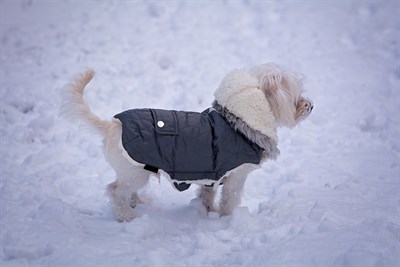How Cold is Too Cold

Heaters are on and blankets seem to have taken over our homes as we bundle up to wait out the winter season. Luckily, we are able to add more layers or turn up the thermostat if we start to feel uncomfortably cold. Our outdoor pets and livestock are not so fortunate, so it is our responsibility to make sure they have adequate shelter from the harsh winter weather and temperatures.
“Animals should be able to get out of the elements,” notes Dr. M.A. Crist, a clinical assistant professor at the Texas A&M University College of Veterinary Medicine & Biomedical Sciences.
“Determining what temperature is too cold for your pet can depend on many different factors, from fur thickness and length to body mass. This makes it hard to determine an exact temperature that could be dangerous to your pet’s health,” explains Crist. “However, it is clinically accepted that indoor pets that are not acclimated to cold weather should not be left outside when the average daily temperature is below 45 degrees Fahrenheit. Cats, even if acclimated to outdoor temperatures should always have access to warm shelters. Kittens, cats advanced in age, or sick should never be kept outdoors when the temperature is below 45 degrees Fahrenheit.”
If pets are kept outdoors during winter weather Dr. Crist recommends making sure the animal has a well insulated structure that is large enough to allow the animal to curl up and maintain its body heat.
“The dog house or structure should contain a wind-block to protect it from northern winter blasts,” advises Crist. “Outdoor pets in colder climates should have an outdoor rated heating pad. Also, adding blankets or dry straw in the structure can give the animal a place to bed down and keep warm. Just make sure the bedding stays clean and dry and remember to change it out frequently.”
Along with a well insulated structure, animals kept outside need plenty of fresh unfrozen water. Heated water buckets are available to make sure your animals stay hydrated.
“During the winter months outdoor pets need a significant number of calories to help keep them warm,” adds Crist. “This increase in caloric intake needs to be maintained throughout the season. Food is the fuel our animals need to maintain their body heat.”
Sweaters can also help to keep pets warm; however there are a few guidelines that need to be followed to ensure your animals safety.
“It is important to make sure the article of clothing fits the animal correctly,” notes Crist. “The sweater should not be large enough to hang loosely or produce gaps that can prevent the animal from keeping warm. On the other hand, you do not want a sweater that is too tight and can cause circulation problems or irritation to the animal’s skin.”
If you choose to provide your pet with clothing it is important to remember to never leave the animal unattended.
“Pet’s clothing can get caught on numerous things outside and that can injure the animal,” explains Crist. “Another worry is that the pet might catch the sweater on something and pull it off, which means the animal will again be unprotected against the cold.”
Crist also suggests a few other guidelines that can help protect your pet from harm this winter:
- Before getting into and starting your vehicle, thump the hood of the car with your hand to make sure a cat seeking refuge from the cold has not crawled up into the engine.
- If you are using antifreeze be careful to clean up any spills. Pets like the taste of antifreeze and it is deadly if ingested, even in very small amounts.
- Products used to help ice melt can be very irritating to the skin and mouth. These products can cause your pet to drool and vomit.
- The use of poison increases in the winter because rats, mice, and other small creatures are often trying to invade our homes to seek shelter during the winter. If you are using poisons around the house make sure they are inaccessible to your pet.
If your pet ingests any type of poison and you need assistance, or you are unsure if a product is safe for use around your animal, talk with your veterinarian. Helpful information can also be found in the pet care section of The American Society for the Prevention of Cruelty to Animals website, www.aspca.org.
With the temperature dropping and an abundance of hazardous materials in use, winter weather means it’s time to take extra precautions to ensure the safety of you, your family, and your pets.
Pet Talk is a service of the College of Veterinary Medicine & Biomedical Sciences, Texas A&M University. Stories can be viewed on the Web at vetmed.tamu.edu/news/pet-talk. Suggestions for future topics may be directed to editor@cvm.tamu.edu.
Angela G. Clendenin
Director, Communications & Public Relations
Ofc – (979) 862-2675
Cell – (979) 739-5718


